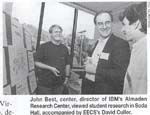
Important Links:
The single overriding message from the meeting was that the collaboration between UCB and IBM around pervasive computing is proving to be extremely effective. It is important. It is in the direction in which new research activities are emerging. It is capturing the imagination of many of the participants and opening up new opens. And, the seed activities started last June have proved very valuable for stimulating this process.The organization of the meeting was structured to build from direct hands-on interations with students and their initial research projects, followed by more focused faculty and graduate student presentations, followed by discussion on how to continue further advance the collaboration.
The collaboration initiated last June has proved to be very successful - far beyond expectations. At that meeting we asserted that it we wanted to change the culture at Berkeley, not just start a new research project. Although we desired to put small, connected devices in the hands of all researchers in the department, we recognized that the infrastructure would not yet exist to support that successfully. Instead, we elected to seed 150 workpads (along with the 50 or so PalmPilots) into selected subsets of the the research community to start creating that infrastructure. This included the researchers involved in the Ninja and Iceberg projects, which are building a new platform architecture for services that provide intelligence in the infrastructure to support small devices, as well as Millennium, which provides the testbed. James Landay ran an experimental version of the User Interface design class (cs 160) with 60 students all working directly with new interfaces for small devices. This also seeded a number of talented undergraduate. In October, we held a kick off seminar to initiate the discussion of what the Post-PC era might bring and what the core research challenges might be. At that we provided workpads to all of the first year CS graduate students. About 20 additional students joined in with their own ideas. Research was conducted as term projects in at least four graduate courses, including operating systems, computer architecture, and network security. Many of these were excellent - and several of these were featured in the meeting. In addition, the effort has created common ground for several important research projects, including NINJA, IRAM, and MASH. It also altered the strategic plan for the department, with most of the critical areas of hiring taking on a pervasive computing flavor. This activity culminated in a major proposal to DARPA, comprising 14 faculty members and a 21M$ budget, to lay out the direction of experimental systems into the 21st century. (A draft of this was provided at the meeting.)
The presentations and projects are available at the agenda page above.
Several action items emerged, listed here from concrete to broad.
David Culler and Eric Brewer are to run a more formal design seminar
in post-PC systems, providing a catalyst and source of vision for the post-PC
bazaar emerging at Berkeley. Dave Patterson is organizing a faculty
friday "great thoughts" meeting.